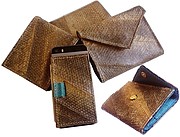Fish to Fabric
As of Friday, May 22, 2015
Your next eco-friendly textile could be fresh out of the ocean.
An Alaska-based company, Tidal Vision, wants to recycle fishery waste products like fish skin and crab shells into textile products.
According to the company, about 2 billion pounds of fishery waste is produced annually in Alaska alone. Typically this waste is dumped back in the ocean or in a landfill, the company says.
All that waste gave Craig Kasberg, an Alaskan commercial fishing captain, the idea to launch Tidal Vision.
“I wanted to created visible products so consumers can show their support for sustainable fishing practices, with the hope to bring more awareness to ocean sustainability,” he said.
Tidal Vision says it’s developed a proprietary method of all-natural aquatic tanning sustainable harvested salmon which produces a salmon leather that can be used for a range of purposes, including accessories such as wallets, purses, bags, belts and footwear, as well as furniture.
Tidal Vision says the salmon leather can be dyed any color and has a similar durability to cow leather but is thinner and resists stretching better. Plus, they say, no fishy scent. Salmon leather apparently smells like traditional leather. The company says the aquatic tanning process can also be adapted to other species of finfish as a way to add value to sustainable harvesting operations or to target invasive species in the ocean.
Tidal Vision has also developed Chitoskin , made from chitosan, which is made from a polymer called chitin found in crab and shrimp shells.
The company has a patent pending for a process to remove chitosan from crab shells without harsh chemicals. Tidal Vision has also build mobile processing units to limit the carbon footprint by extracting the chitosan where the crab is landed and processed.
Chitosan is biodegradable and has antibacterial and antimicrobial properties. Plus, it’s safe for people with shellfish allergies, Tadal Vision says. The company’s extraction method also gives the end material a high tensile strength. Chitosan yarn can then be blended with other fibers such as Tencel, polyester, wool or cotton.
The company sees applications for apparel such as shirts, socks, base layers, underwear and performance activewear.
Tidal Vision is launching the salmon skin leather on Kickstarter on May 27th. Chitoskin is expected to launch this fall.

